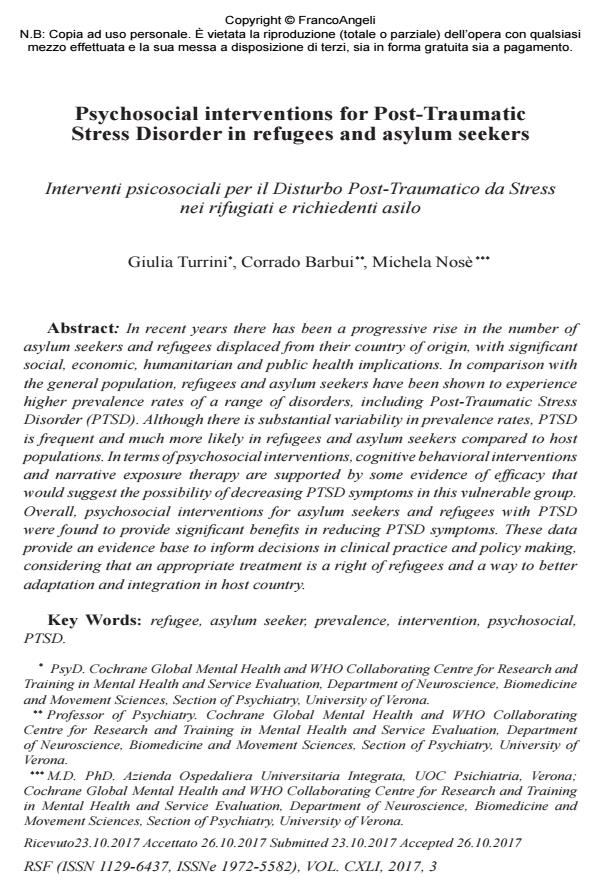Psychosocial interventions for Post-Traumatic Stress Disorder in refugees and asylum seekers
Titolo Rivista RIVISTA SPERIMENTALE DI FRENIATRIA
Autori/Curatori Giulia Turrini, Corrado Barbui, Michela Nosè
Anno di pubblicazione 2017 Fascicolo 2017/3
Lingua Inglese Numero pagine 16 P. 51-66 Dimensione file 696 KB
DOI 10.3280/RSF2017-003004
Il DOI è il codice a barre della proprietà intellettuale: per saperne di più
clicca qui
Qui sotto puoi vedere in anteprima la prima pagina di questo articolo.
Se questo articolo ti interessa, lo puoi acquistare (e scaricare in formato pdf) seguendo le facili indicazioni per acquistare il download credit. Acquista Download Credits per scaricare questo Articolo in formato PDF

FrancoAngeli è membro della Publishers International Linking Association, Inc (PILA)associazione indipendente e non profit per facilitare (attraverso i servizi tecnologici implementati da CrossRef.org) l’accesso degli studiosi ai contenuti digitali nelle pubblicazioni professionali e scientifiche
In recent years there has been a progressive rise in the number of asylum seekers and refugees displaced from their country of origin, with significant social, economic, humanitarian and public health implications. In comparison with the general population, refugees and asylum seekers have been shown to experience higher prevalence rates of a range of disorders, including Post-Traumatic Stress Disorder (PTSD). Although there is substantial variability in prevalence rates, PTSD is frequent and much more likely in refugees and asylum seekers compared to host populations. In terms of psychosocial interventions, cognitive behavioral interventions and narrative exposure therapy are supported by some evidence of efficacy that would suggest the possibility of decreasing PTSD symptoms in this vulnerable group. Overall, psychosocial interventions for asylum seekers and refugees with PTSD were found to provide significant benefits in reducing PTSD symptoms. These data provide an evidence base to inform decisions in clinical practice and policy making, considering that an appropriate treatment is a right of refugees and a way to better adaptation and integration in host country.
Negli ultimi anni si è registrato un progressivo aumento del numero dei rifugiati e dei richiedenti asilo arrivati in fuga dai loro Paesi di origine, con implicazioni significative sul piano sociale, economico, umanitario e sanitario. Sebbene ci sia una notevole variabilità nei tassi di prevalenza delle patologie psichiatriche, i dati della letteratura confermano che il PTSD è molto frequente nella popolazione dei rifugiati e richiedenti asilo rispetto alle popolazioni dei Paesi ospitanti. Per quanto riguarda l’efficacia degli interventi psicosociali nel trattamento del PTSD in questa popolazione, le ultime evidenze della letteratura suggeriscono che gli interventi cognitivo-comportamentali e la terapia di esposizione narrativa sono supportati da prove di efficacia e che, in generale, esistono interventi psicosociali efficaci nel diminuire i sintomi di PTSD rispetto ai gruppi di controllo. La possibilità di identificare e trattare precocemente i sintomi psichiatrici in questa popolazione particolarmente vulnerabile ha un impatto importante non solo in termini di Salute Mentale, ma soprattutto, incidendo sulla possibile integrazione del rifugiato e sul suo migliore adattamento all’interno del Paese ospitante, ha implicazioni rilevanti per la organizzazione dei Servizi Sanitari, inclusi quelli di Salute Mentale.
Parole chiave:Rifugiato, richiedente asilo, prevalenza, intervento, psicosociale, PTSD.
- Feasibility and predictors of change of narrative exposure therapy for displaced populations: a repeated measures design Rina S. Ghafoerkhan, Henriette E. van Heemstra, Willem F. Scholte, Joriene R. J. van der Kolk, Jackie June F. ter Heide, Simone M. de la Rie, Linda M. Verhaak, Evelien Snippe, Paul A. Boelen, in Pilot and Feasibility Studies 69/2020
DOI: 10.1186/s40814-020-00613-1
Giulia Turrini, Corrado Barbui, Michela Nosè, Psychosocial interventions for Post-Traumatic Stress Disorder in refugees and asylum seekers in "RIVISTA SPERIMENTALE DI FRENIATRIA" 3/2017, pp 51-66, DOI: 10.3280/RSF2017-003004